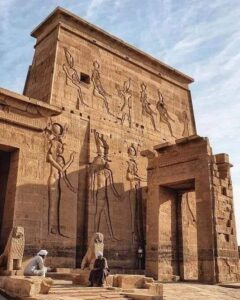Introduction
Nestled on Philae Island near Aswan in southern Egypt, the Temple of Philae is a stunning example of ancient Egyptian architecture and devotion. Dedicated to the goddess Isis, this temple complex not only reflects the artistic and architectural achievements of the Ptolemaic dynasty but also serves as a testament to the enduring legacy of Egyptian culture and religion.

Historical Context
Constructed between 305 and 30 BC during the Ptolemaic dynasty, the Temple of Philae was built to honor Isis, one of the most significant deities in ancient Egyptian mythology. Isis was revered as the goddess of magic, motherhood, and fertility, and her cult was widely followed throughout Egypt and beyond. The temple complex also includes several smaller sanctuaries dedicated to other gods and goddesses, showcasing the rich tapestry of Egyptian religious practices.
Architectural Marvel
The Temple of Philae is celebrated for its exquisite hieroglyphics and Greco-Roman architectural influences. The temple features intricately carved reliefs that depict various mythological scenes, including the story of Osiris and Isis. The architectural layout, characterized by majestic columns and grand halls, exemplifies the blending of Egyptian and Hellenistic styles, marking a unique period in the evolution of ancient Egyptian architecture. Notable structures within the complex include the Kiosk of Trajan, which stands as a testament to the Roman influence on Egyptian building techniques.

Preservation Efforts
One of the most remarkable aspects of the Temple of Philae is its preservation. After the construction of the Aswan Dam in the early 20th century, the temple was submerged for decades, posing a significant threat to its existence. Recognizing the cultural and historical importance of the temple, an international campaign was launched in the 1970s to relocate it to a nearby island. This monumental effort, supported by UNESCO and various countries, involved carefully dismantling the temple stones and reconstructing the complex on higher ground. The successful relocation not only saved the temple from flooding but also highlighted the global commitment to preserving cultural heritage.
UNESCO World Heritage Site
In 1979, the Temple of Philae was designated a UNESCO World Heritage Site as part of the Nubian Monuments. This recognition underscores the temple’s significance as a cultural landmark and its role in the broader context of ancient Egyptian history. Today, it attracts thousands of visitors from around the world, eager to experience its beauty and learn about its storied past.

Cultural Impact
The Temple of Philae continues to inspire scholars, artists, and tourists alike. Its artistic legacy, particularly the detailed carvings and inscriptions, provides invaluable insights into ancient Egyptian beliefs and daily life. The temple is also a focal point for modern interpretations of ancient spirituality, with many visitors finding a sense of connection to the past as they explore the sacred site.
Conclusion
The Temple of Philae stands not only as a remarkable architectural achievement but also as a symbol of resilience and preservation. Through the efforts of international cooperation, this ancient temple has been saved from the ravages of time and water, allowing future generations to appreciate its beauty and historical significance. As a tribute to the goddess Isis and a testament to ancient Egyptian culture, the Temple of Philae remains a timeless treasure on the banks of the Nile, inviting all who visit to marvel at its grandeur and reflect on the enduring legacy of one of the world’s oldest civilizations.
